NEWS:
I have updated the Synth 1 bank on the sound design page located in the Music section of the site. I mainly updated some patches to have more expressive modwheel changes, and if you have the previous bank, you’ll see that the updated version will have the _MW suffix denoting which patches now also have modwheel expression added.
WEBLOG:
I don’t know when I started to hate flying, but when I was younger I used to enjoy even the long international flights. It’s as if something finally caught up with me, or something in me snapped. Now I hate flying with a passion. If I never have to fly again, I wouldn’t miss it. The long lines, the security checks, the cramped and uncomfortable seats that kills my back and tailbone, the screaming babies, the neighboring guy with B.O., the aisles blocked with food carts when your bladder is about to burst (or worse). I have no idea why I ever enjoyed flying. I guess when you’re young you think of flying as adventuring–heading towards something different, new, exciting. Now flying is just jetlag, sore back, heavy luggage, and waiting in lines.
Our return trip back to China wasn’t as smooth as we had hoped. We were prepared to pay the overweight fee for our large suitcases ($25 each if over 50 lbs., but cannot exceed 70lbs. That’s $100 for 80 lbs. total), but when we were asked to weigh out carry-on luggage, we ended up having to pay another $84 because our carry-on’s were too heavy and we needed to shuffle the contents around and check in the heaviest one. I sat there on the floor trying to divide the carry-on contents into fragile (external hard drives, digital multi-track recorder, MIDI controllers) and relatively more durable (audio interfaces, monitor controller, XBox 360). Eventually I got it all sorted out, and I think overall, $184 for about 120 lbs. was still a huge bargain compared to shipping the same weight internationally.
…
China has once again banned popular sites like Youtube, Twitter, Facebook…etc, but LiveJournal is now unbanned (it was banned for quite a while). This is one of the worst things about living in China–the constant banning of this and that. I wonder if we will ever see the day when freedom of speech and press becomes a reality in China. If Hong Kong and Taiwan can make it happen, so could China–eventually.
…
After lugging all the new gear back with me, I had to figure out a way to make enough room in the studio, and after shuffling some stuff around, I managed to integrate all the new gear into the studio. Here’s how I have them in the studio:
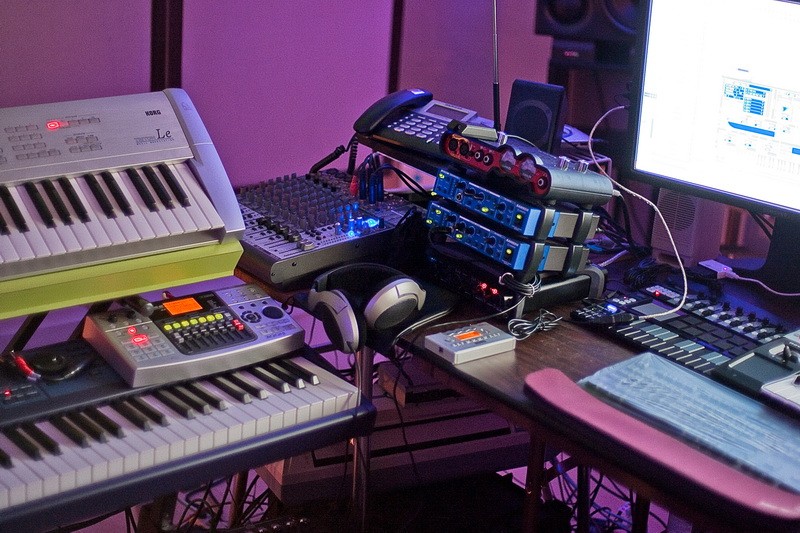
The Zoom MRS-8 Digital Multitrack sits right on the Kurzweil PC2X. The Korg Pandora sits close to the audio interfaces. The additional Samson C-Control stacks on top of the old one, with the TC Electronic Konnekt Live on the bottom and the Line 6 Toneport UX2 on top of the stack. The Korg Nanos sit on the left side of the Novation ReMOTE 25 SL, and the NanoKEY is usually set to two octaves lower, so I can play four octaves continuously from the NanoKEY to the ReMOTE 25 SL.
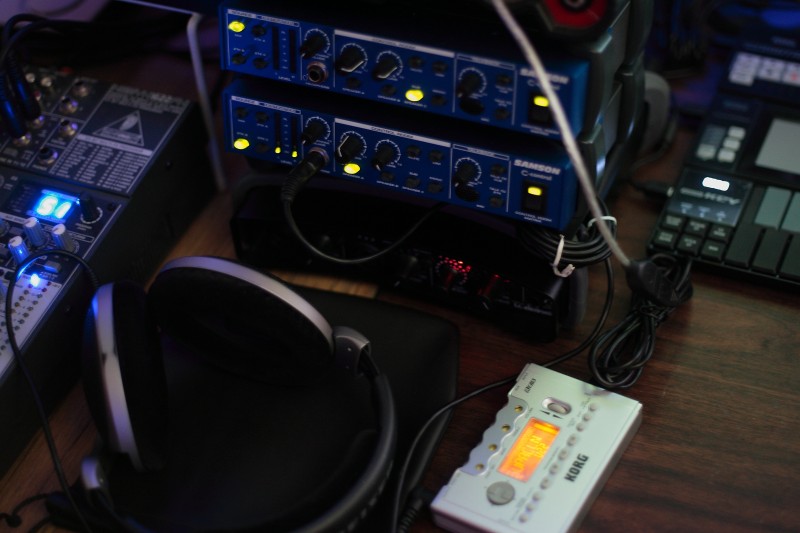
As you can see, the Konnket Live is all black, and the faceplate is an inset, so it’s very hard to see unless I turn on the bright lights in the studio, and I’d still have to bend down. Maybe I should move it up the stack.
With bright light on, I can read the Konnket Live’s faceplate. The problem is, I almost never turn on the bright lights unless I’m fixing gear or I dropped something tiny on the floor.
Since Konnekt Live is designed for live use, this is the kind of lighting most musicians will see their Konnekt Live in. I really have to question TC Electronic’s wisdom behind choosing both black and an inset faceplate for this interface. There are other ways to protect the faceplate for gigging–like a snap on cover maybe? The 24D (similar but cheaper model) on the other hand, is white and very easy to see even when it’s relatively dark.
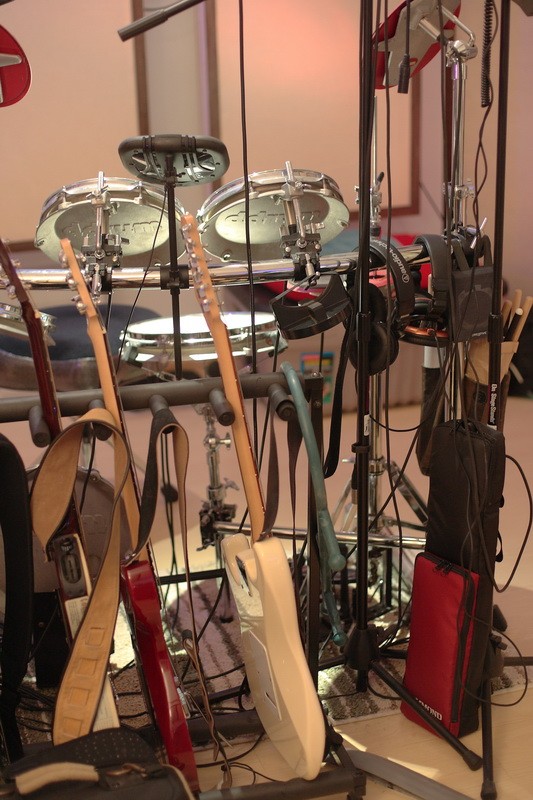
The Suzuki Hammond 44 Melodion stays inside its gig bag and rests between the mic stands.
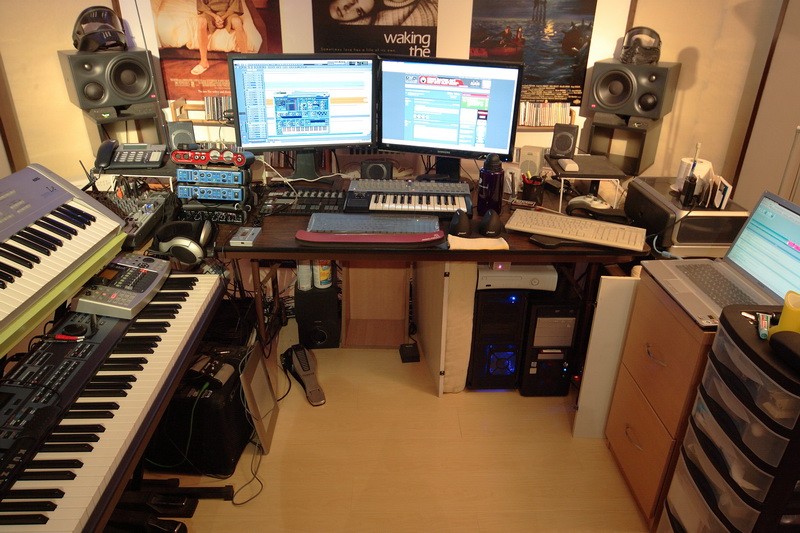
The space where the white QWERTY keyboard is will be where the Zendrum will go once I get it back (it’s was sent back for some minor tweaks). The Roland FD-8 hi-hat pedal is right in front of my on the floor. I have yet to get it to work properly with the Zendrum, but I’ll figure it out eventually. The new Sony VAIO laptop goes on my right. I have plans to run either MIDI Over LAN or TeleportFX so that the Sony can become part of the DAW rig instead of only being used when I’m traveling.
I’m contemplating adding four 1.5TB SATA drives to the main desktop DAW, and then add four more gigs of RAM and install a 64-bit OS so I can use 8GB of RAM (the motherboard only allows up to 8GB of RAM). A few of the plugins I use won’t even install on 64-bit OS (I tried it on the Sony VAIO, which is running Vista 64-bit), but I think the overall improvement will be worth it. Having orchestral sections spread among four hard drives and 8GB of RAM, I should be able to do just about anything except the really insanely complex orchestrations.
…
I spent some time putting the new TC Electronic Konnket Live firewire audio interface through its paces, and it’s not performing as well as I had hoped on my WinXP 32-bit desktop DAW. I get audio drop outs here and there, and the latency doesn’t go as low as I feel a really good audio interface should go. I also did extensive listening tests comparing the Konnekt Live to my aging Audiotrak Prodigy 7.1 PCI audio card, and I really couldn’t hear any difference between the two interfaces. For all the hype about TC Electronic’s D/A converter, it doesn’t sound any different than the Prodigy 7.1, which is a prosumer audio card. My studio has full-blown acoustic treatment and my monitors are reference quality high-end monitors (Klein + Hummel O 300D’s), so I know my listening environment is fine. In the past I’ve done listening tests comparing my Line 6 Toneport UX2 to the Prodigy 7.1, and there weren’t any differences I could detect either. Ethan Winer of Realtraps is very outspoken about what he perceives as esoteric niche voodoo mumbo jumbo when audiophile and pro audio guys go on and on about the sound quality of D/A converters, and the tests he conducted also showed no difference between consumer audio cards and higher-end professional audio interfaces. I personally don’t care either way, because I have no complaints about how my audio cards and interfaces have sounded in the past (except for stability issues), so if they all sound just as good, I’m ok with that. However, I’m not ok with paying extra for so-called better converters if I can’t hear the difference.
…
I bought Leonard Bernstein’s Young People’s Concerts series (9 DVD set) based on a fellow composer’s recommendation, and it’s such a pleasure to watch Bernstein’s love for music and passion for teaching in the classic series. Bernstein would explain very complex ideas about music so that even children could understand them, and that is a rare gift. He’s also a very expressive and infectious conductor, practically dancing on the podium and swaying with the music. I just finished disc 2 and I’m looking forward to the rest of the collection.
…
LA Scoring Strings is currently a hot topic in the composer circle, as it sounds amazing and takes a different approach compared to the previous commercial string libraries. Sampling different chairs of each section is a great idea, and I’m surprised no one’s done it until now. The cellos in the audio demos sound particularly good. Check them out:
http://www.audiobro.com/html/demos.html
…
I spent some time trying out the demo version of Waldorf Largo, the latest product from one of my favorite synthesizer companies, and while I think it’s a good synth, it’s got a very dated preset manager/browser, which is kind of odd given how almost all of today’s high profile synths all have modernized and intuitive preset manager/browsers. It’s not like the Waldorf guys don’t have enough software experience either–they’ve done the PPG Wave 2, Attack, D-Pole, and members of Waldorf development have worked on Komplexer and Neuron. How is it that they could have overlooked something so important like the preset manager/browser?
…
I just tried out the open beta version of ACDSee Pro 3, and I must say that as a very long time user of ACDSee (since the very first version back in the 90’s), I am for the first time truly impressed with a new version. When ACDSee first went down the road of adding features, it floundered around for years as a bloating mess that constantly crashed and had horribly confusing GUI. The only reasons I kept on using it was because it was one of the first image browsers that provided anti-aliasing, and when I only needed to do minor image editing, it allowed me to do it without opening up Photoshop (which by then had become very slow on startup, and remains that way to this day). The tagging feature was also sometimes very helpful when I’m managing image choices for projects. But as soon as XnView (my favorite freeware image brower/editor) implemented anti-alising and tagging, I tried to avoid ACDSee whenever possible, unless I needed to do a quick image crop. When the Pro version was launched, things improved improved, but the crashing continued, until around version 2.5, when it finally stabilized a bit.
And now, ACDSee Pro 3 is the first version that made me smile and my eyes sparkle as I try out the new GUI and image processing features. They really went for a professional look by using a dark color scheme, and the new viewer is quite flexible and easy to use, while retaining all the old features and hotkeys. The new Compare feature is a nice addition, as is the Navigator. The new Processing features are very detailed and powerful, but it’s slow as hell compared to dedicated photo editing applications like Lightroom or Canon Digital Photo Professional. I’ve been using DPP for years now and even though it’s not as feature-rich as the high profile commercial applications, it’s color renditions and interpretation of Canon’s color profiles are by far the most pleasing. Well, it should be since Canon developed it for their own cameras. I just wish that DPP will add highlight/shadow recovery, fill light, and vibrance. If they can do that, I probably won’t need to use any other RAW processor/editor.
…
Quickie Film/TV reviews:
Day Zero – I enjoyed the film, although Elijah Wood’s character depressed the hell out of me. It’s interesting that when he’s not portraying a pure and innocent soul, there’s just something kind of off about him, and I thought that oddness suited his role in this film very well. I used to wonder what I’d do if I got drafted, so I can totally relate to what the characters went through in the film.
Watchmen – I was really excited when the trailer first came out, and being a huge fan of Zack Snyder’s Dawn of the Dead remake, I had high hopes for Watchmen (even though 300 didn’t do much for me). While the film wasn’t bad, it also wasn’t very good either. In general I’m not a fan of editing gimmicks–that whole slowing down and speeding up the frames–just feels too contrived. It worked for The Matrix because the premise itself was perfect for that approach, but I think most directors misuse those techniques. It’s been at least 10 years since I read Watchmen, so I can’t really remember enough of it to compare the details, but I do remember the feeling I got after finishing reading–it was one of those experiences that’s truly awe-inspiring and unique. The film doesn’t even come close to eliciting that kind of emotional or intellectual resonance.
The Assassination of Jesse James By the Coward Robert Ford – I was very impressed by Casey Affleck’s acting in this film. He’s far better than his older brother Ben, and even Ben admitted it publicly. I think it’s a good thing that Ben is now directing and good at it, because I think he’ll have a brighter future as a director than as an actor. As an actor, Ben really just became the good-looking lead who can’t really act (like Keanu Reeves), and while a fate like that would actually be a dream-come-true for some people, I think Ben Affleck’s an intelligent guy and he wouldn’t have been satisfied with that fate. The fact he’s directed a good film (Gone Baby Gone) and co-written good screenplays is proof of that.
Princess Blade – For a low budget B-movie it’s not bad, but it’s also extremely simple in both plot and character development. The sword play really isn’t all that impressive–we’ve all seen better choreographed sword fights in films. The subplot with the guy and his sister seemed totally out of place and unnecessary, especially the ending. If the ending had been different, then I could see the point, as they’d provide some kind of emotional satisfaction and closure for the protagonist.
Lost (season five) – The fifth season of Lost was just as intense as the fourth season, and I can’t wait for the final season. The writers made sure to answer more questions than they were asking, and many of the plot twists and progressions were very satisfying. If any of you dropped Lost from your list of shows to follow back around season two or three, I strongly urge you to pick it up again, because starting with season four it kicked into overdrive and season five was just as exciting.
True Blood (season one)– I keep seeing ads for this show, and I was skeptical since I’ve never seen a single vampire TV show I liked (though there are some excellent ones in feature films). Unfortunately, True Blood doesn’t change a thing for me–it’s ok, but nothing to write home about. What’s even worse is that prior to watching this show, I considered myself a fan of Anna Paquin and followed her career, but True Blood actually turned me off her to the point where I no longer care what she did next.
My problem with True Blood isn’t necessarily the mixture of campy black comedy with a bunch of redneck characters, romance, and vampires–I have no problem with that combination. What annoys me about True Blood is the lack of characters that we could really care about and root for. Sookie Stackhouse is supposed to be the character we care about, but for me personally, I just didn’t see anything about her that makes me want to care about who she dates or what happens to her. In fact, she’s downright annoying at times with her self-righteous bullshit and selfish immaturity. The men attracted to her keep saying she’s so different, but if her telepathic ability is the only thing interesting about her, then the writers have failed because the audience needs hell of a lot more than just a supernatural ability to care about a character. If we don’t think she is interesting, then it’s hard to convince us the males leads in the show would feel that way about her. It seems the writers try to convey that Sookie is supposed to be sweet and gentle soul, and that’s part of her appeal, but after watching a whole season, she moments of bitchiness appears to outweigh her moments of tenderness.
Then there’s is Tara, the ill-tempered best friend to Sookie. As a personal preference, I really don’t have much interest in watching very dysfunctional people on the screen, because they are just as off-putting as they are in real life, and if I avoid them in real life, why would I waste my time on them in my entertainment? I don’t find them entertaining to watch–only frustrating and anger-inducing. I far more prefer to watch extraordinary things happen to people I can respect with qualities like intelligence, maturity, resourcefulness, courage, compassion, selflessness…etc, because watching them deal with extraordinary situations while demonstrating such admirable qualities is actually inspiring and maybe even educational. Watching very dysfunctional people make a mess of their lives just tries my patience because it’s like watching a very stupid dog chasing its own tail–pointless, pathetic, and only amusing for the first few minutes.
What’s also disappointing is the overall level of depth of the storytelling–it’s really not all that deep. There are so many ways they could explore the social aspect of vampires living among humans, but they resort to the most shallow and simple depictions. None of the characters have the kind of depth that would be compelling to a critical and intelligent viewer, and it’s unfortunate because the whole idea of doing a cable TV series is to not have to cater to the lowest common denominator of the mainstream. True Blood stripped of the graphic sex and violence feels about as shallow as the typical mainstream TV show from the 80’s or 90’s (today’s mainstream TV shows are far better than those in the past). Even the stylistic choices feel lackluster. The opening credits are far more compelling than the show itself. Why couldn’t they have done the show with the sensibility of the opening credits? Or maybe do a Coen Brothers kind of approach–compelling strange and interesting characters with a surrealistic vibe that permeates the premise. But noooooo, True Blood is written and directed with such blandness that its graphic sex, violence, and adult language becomes just a gimmick to give the show some edge–edge that it otherwise would be completely lacking.
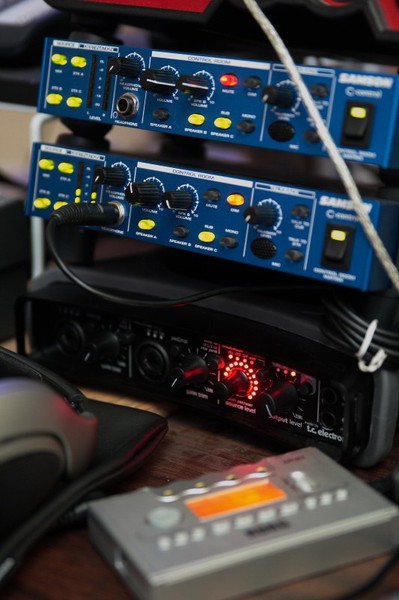
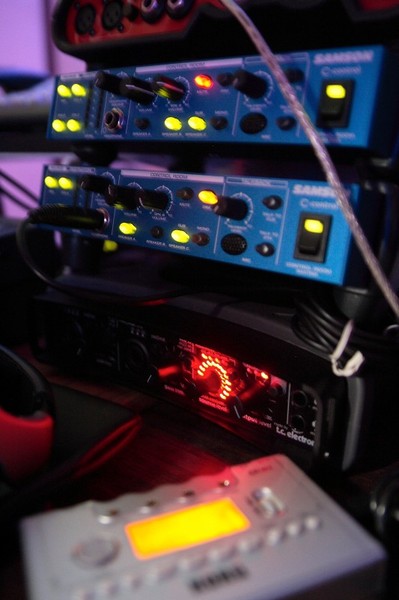
Stumbled on your page, and wanted to compliment you on a wicked looking studio. Style totally matters, mine is still kind of a hole in the wall! (I need a lava lamp).
I’m a newish composer from the west coast as well, but sadly, my primary source of income is software development and not music, as I’d prefer. Not unlike yourself, I am immensely interested in writing for games and film, so I found your website to be enjoyable and refreshing; It’s inspiring to to read about people who are ahead of you, but not yet Harry Gregson Williams or “The Zimmer”.
Cheers